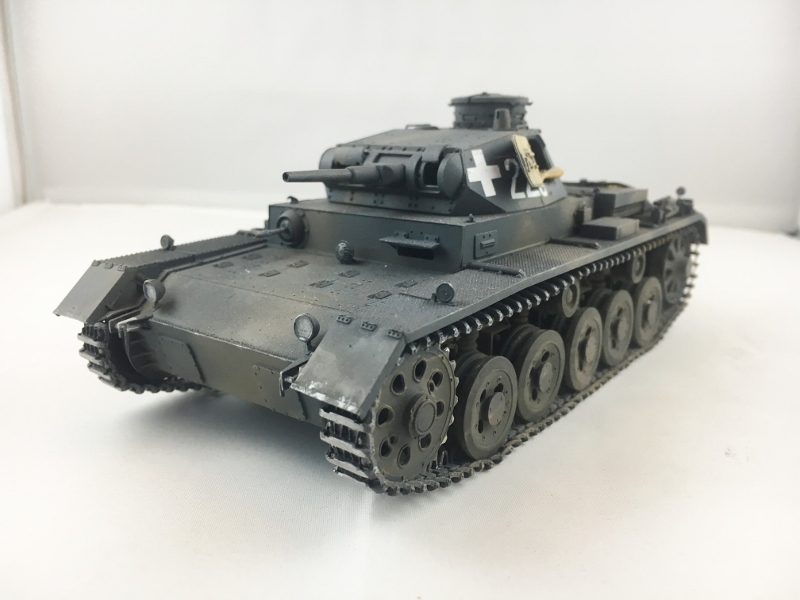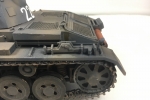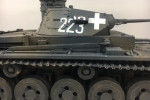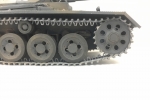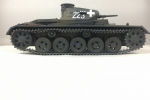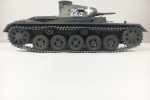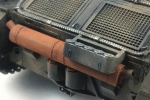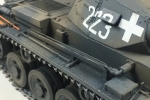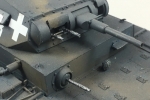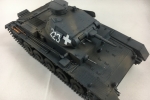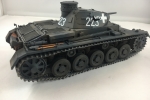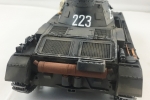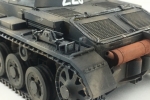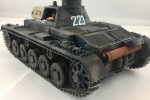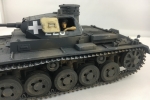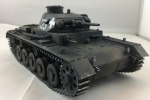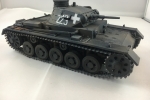1⁄35Bronco Pz IIIA
19
Comments
After completing his build review on Bronco`s Pz.Kpfw. III Ausf A (Sd Kfz 141), Bill finished off the build with the standard Wehrmacht Dunkelgrau paint scheme with decals to represent a vehicle of the 1st Panzer Division in Poland, 1939.
Comments
Thank you all for your enthusiasm. Here are the answers to your questions:
While distributed by Bronco, this kit is essentially in the same family as the MiniArt kits. In fact, you can interchange parts like the cupola episcopes (thanks to Georg Eyerman for clarifying they aren't really periscopes). The rear engine deck problems are the same, too. The tracks are identical down to the assembly "jig" that's included.
Moritz, I'm not sure what you mean by "bandages." Can you upload a photo with the part in question circled? Do you mean the round covers at the center of the roadwheels? They are like hubcaps covering the attachment bolts for the wheels. Overly ornamental? That criticism could be applied to much of Germany's AFVs during the interwar period: excessively-complex manufacturing and fabrication that required heavy equipment that was both hard-to-make and easily destroyed by air raids.
Overall, the road wheels with their leaf springs, shock absorbers, etc. are a direction German armor explored between the wars and abandoned in favor of torsion-bar suspensions from the Ausf. E onward.
JAN 07, 2017 - 09:52 PM
Hello Mr. Cross, you are right, I mean the bandages of the roadwheels. On your first big picture you can clearify this rim on each roadwheel. I ask myself since I got the kit: Why should you drive a tank on rubber bands with a bump?
JAN 08, 2017 - 12:28 AM
Moritz, I must be dense, but I don't get your meaning at all. Perhaps someone else here can help? If you mean the rubber tires on the road wheels, all German AFVs had them until late in the war when oil shortages prevented the production of synthetic rubber. The intention was to absorb some of the vibration from the tracks.
If you mean something else, let's talk privately and perhaps in German so I can understand your question better.
JAN 08, 2017 - 11:57 PM
I think he is saying there is an issue with the rubber portion of the wheels.
JAN 09, 2017 - 01:04 AM
Hello Mr. Cross, I mean the rim on the roadwheels of the model. I´ve made a few Pictures of the wheels and I hope you´ll better understand my question. Best regards. Moritz
JAN 10, 2017 - 10:34 PM
There is some kind of lip on the edge of the rubber road wheel, that shouldn't be there if one goes by the illustration.
Is that supposed to be there, I guess is the question?
JAN 15, 2017 - 01:06 AM
Never use an illustration to determine historical accuracy. I went to Panzer Tracts 3-1 and checked there. I couldn't find anything verbal about it, and the photos were limited, since there were only a handful of these vehicles built. But the photographic evidence seems to suggest some kind of "lip" on the rubber road wheels that might be a production seam or something for installing them on the metal rims. In other words, I don't see any convincing evidence the kit maker was incorrect, but no evidence supporting their parts, either. I doubt the lips lasted very long, so if you feel uncomfortable, sand them off.
JAN 22, 2017 - 11:10 PM
Copyright ©2021 by Bill Cross. Images and/or videos also by copyright holder unless otherwise noted. The views and opinions expressed herein are solely the views and opinions of the authors and/or contributors to this Web site and do not necessarily represent the views and/or opinions of Armorama, KitMaker Network, or Silver Star Enterrpises. All rights reserved. Originally published on: 2017-01-05 22:31:43. Unique Reads: 10707




